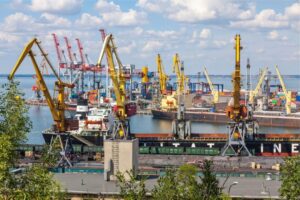
On Sunday, October 9, some 13 ships with 230,700 tonnes of agricultural products for the countries of Africa, Asia and Europe left the ports of Odesa, Pivdenny and Chornomorsk, the Ministry of Infrastructure of Ukraine reported.
“Among them are the bulk carriers ARGONAUT, carrying 71,000 tonnes of wheat for Indonesia, the ALI A (7,000 tonnes of wheat for Lebanon) and the MEHMET BEY (8,000 tonnes of soybeans for Egypt),” the press service informs.
Since the start of the grain corridor operation, 305 ships have exported 6.8 million tonnes of Ukrainian food to the countries of Africa, Asia and Europe.

By order of the chief dispatcher of NPC Ukrenergo, power supply to some industrial enterprises and household consumers was temporarily limited in Kyiv and the Kyiv region, the duration of the outages will be about two hours, DTEK Grids said.
“In order to maintain the integrity of the energy system, NPC Ukrenergo has decided to temporarily limit power supply in Kyiv and the region. With this order, Ukrenergo turned to DTEK Kyiv Electric Grids and DTEK Kyiv Regional Electric Grids,” DTEK Grids said in a release.
The outages are expected to last around two hours to balance the country’s power grid, according to the release.

NATO Secretary General Jens Stoltenberg had a conversation with Ukrainian Foreign Minister Dmytro Kuleba in connection with massive rocket attacks on Ukrainian cities on the morning of October 10.
“Speaked to Foreign Minister Kuleba and condemned Russia’s horrendous and indiscriminate attacks on civilian infrastructure in Ukraine. NATO will continue to support the courageous Ukrainian people in fighting the Kremlin’s aggression for as long as it takes,” Stoltenberg tweeted.
civilian infrastructure, NATO, Russian attacks, SECRETARY GENERAL

European stock indexes are falling during trading on Monday following the stock markets of the Asia-Pacific region (APR).
Market sentiment continues to be influenced by concerns about the impact of higher interest rates on global economic growth, writes Trading Economics. In addition, the situation in Ukraine is again in the focus of investors’ attention.
The composite index of the largest enterprises in Europe Stoxx Europe 600 by 11:17 qoq fell by 0.63% to 389.21 points.
The German DAX loses 0.27%, the French CAC 40 – 0.9%, the British FTSE 100 – 0.71%, the Italian FTSE MIB – 0.53%. The Spanish IBEX 35 is down 0.6%.
The Bank of England will increase the maximum volume of daily auctions for the purchase of government bonds as part of a temporary program, the launch of which it announced on September 28. The British Central Bank still plans to fully complete the redemption of government bonds on Friday, October 14, according to its press release. Since the launch of the program, the regulator has held 8 auctions, in which it bought bonds for a total of 5 billion pounds ($5.5 billion), although it was ready to purchase papers for 40 billion pounds.
Shares of TotalEnergies (SPB:TOT) SE fell 1.5%. The energy company has offered to hold annual wage talks with unions in France ahead of schedule, subject to the completion of strikes at refineries.
British online retailer THG PLC is the drop leader, dropping 7.8%.
In addition, the shares of the German energy company Uniper SE (-7.5%) and the manufacturer of lighting equipment ams-OSRAM AG (-6.7%) are getting cheaper.
Renault SA gained 3.1% after the French automaker confirmed it was in talks for an alliance with Japan’s Nissan Motor Co., including a potential investment in Renault’s new electric car business.
Shares of Societe Generale SA are up 0.8%. French bank COO Galle Olivier will leave the company at the end of the year amid a management reshuffle, Societe Generale said in a statement.

JSC Ukrzaliznytsia warns of the delay of 38 trains as a result of Russian rocket attacks and damage to the contact network caused by them, UZ reports on its telegram channel on Monday.
“As of now, 14 trains are moving with a delay of up to 30 minutes; 24 flights with a delay of 30 minutes or more,” the company said.
According to the report, the Kyiv railway station is already open for passengers to enter and exit, and boarding and disembarking of passengers is carried out according to the schedule.
In addition, UZ, in partnership with World Central Kitchen, has prepared supplies of water and food in order to receive passengers of all flights arriving after curfew today at the station overnight.
UZ is ready to advise passengers on all issues through the contact center at 0800 503 111, in chat bots and on official pages on social networks.

Interruptions are possible in the work of checkpoints on the border with the European Union and Moldova, the State Border Guard Service of Ukraine has warned.
“Due to enemy shelling and damage to critical infrastructure facilities in western Ukraine, there may be interruptions in the operation of checkpoints on the border with the EU and Moldova,” the State Border Guard Service said in the Telegram channel on Monday.